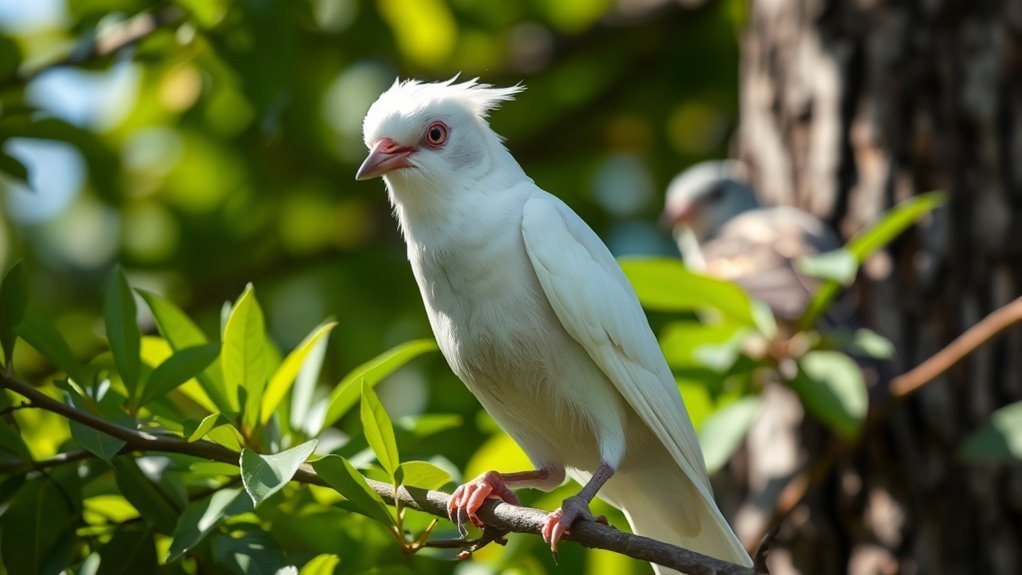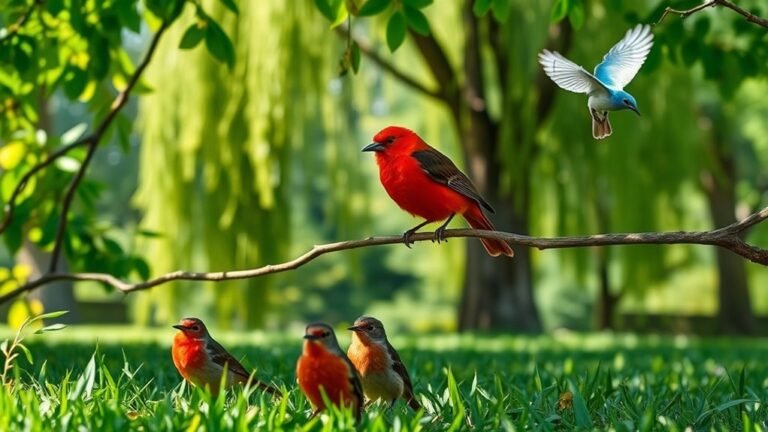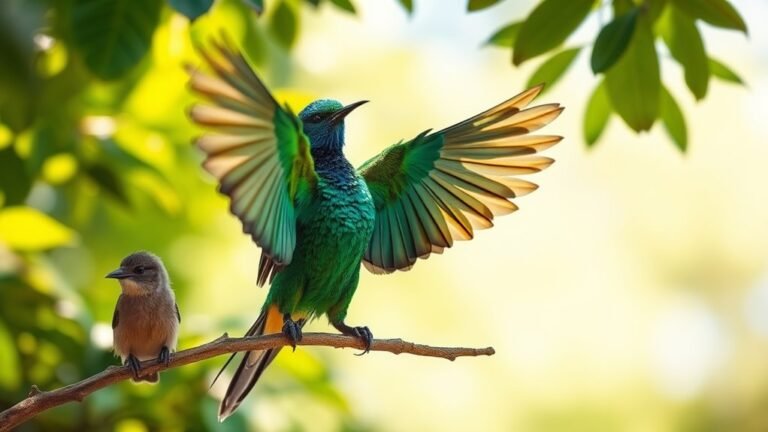How Rare Are Albino Birds in Nature?
Albino birds are rare in nature, occurring in approximately 1 in 1,700 cases. Their white feathers make them visually striking but also vulnerable. These birds struggle to camouflage in their environments, which can lead to a higher risk of predation. The genetic condition that causes their albinism affects their survival and reproduction rates.
Key factors contribute to the rarity of albino birds. First, their lack of pigmentation makes them stand out, making it hard for them to hide from predators. Second, they may face complications related to vision and health due to the albinism. As a result, fewer albino birds survive to adulthood and reproduce.
Understanding the challenges faced by albino birds helps highlight the impact of genetics on wildlife. Their unique appearance captures our attention, encouraging us to learn more about their lives and how they adapt to their environments.
Key Takeaways
- Albinism occurs in approximately 1 in 1,700 birds, making it a rare genetic condition in avian populations.
- Genetic changes that affect melanin production lead to varying prevalence rates among different bird species.
- Common species with albinism include the American robin, black-capped chickadee, and pigeons.
- Urban environments may showcase more visible albino birds, such as white crows and song sparrows.
- The rarity of albinism contributes to unique challenges, including increased predation risks and reduced reproductive opportunities.
Understanding Albinism: A Genetic Overview

Albinism is a genetic condition caused by mutations in genes that produce melanin, the pigment responsible for color in feathers, skin, and eyes.
These mutations result in reduced or absent melanin. The impact of albinism goes beyond appearance; it affects survival. Albino birds are more vulnerable to predators and more sensitive to sunlight because they lack pigmentation.
Understanding the genetics of albinism helps us appreciate its significance in nature. Each albino bird faces unique challenges, highlighting the intricate balance of life in the wild.
This knowledge can deepen our connection to the natural world.
Prevalence of Albinism in Bird Populations
Albinism affects about 1 in 1,700 birds, making it uncommon in most species. This condition happens due to genetic changes that impact melanin production.
Birds with albinism often face more dangers in the wild. Their lack of color makes them more visible to predators, which can reduce their chances of survival. Additionally, albinism can affect their vision, making it harder for them to find food and avoid threats.
Some bird species show slightly higher rates of albinism. This difference may be due to their genetic traits and the challenges they face in their environment.
Recognizing these factors can help us understand the unique difficulties that albino birds experience in nature. Appreciating these challenges can deepen our connection to wildlife and foster empathy towards these rare creatures.
The Science Behind Feather Coloration

Feather color in birds comes from genetics, pigments, and environment. Birds have vibrant colors due to two main factors: structural coloration and feather pigmentation. Specific genes influence how birds produce pigments like melanin and carotenoids.
These pigments not only affect appearance but also help with camouflage, mating, and recognizing species. Watching bird colors can enhance your appreciation for evolution's role in these traits.
Changes in diet and habitat can make colors more intense or dull, highlighting how dynamic bird coloration can be. This understanding fosters a deeper connection to birds and nature.
Common Species Exhibiting Albinism
Birds can display albinism, a genetic condition that reduces melanin. This results in white or pale plumage, making the birds visually striking.
Common examples include the American robin, black-capped chickadee, and pigeons. In cities, you might see white crows or albino song sparrows.
These unique appearances draw attention but also present challenges. Albino birds are often more vulnerable to predators due to their lack of camouflage.
Learning about albinism helps you appreciate these rare birds and strengthens your connection to the avian world.
The Role of Camouflage in Bird Survival

Many bird species use bright colors to attract mates, but camouflage is vital for their survival. Birds have developed various camouflage techniques to hide from predators and blend into their surroundings. For example, some birds mimic plants, while others change their colors with the seasons.
Ground-nesting birds often have earthy colors, which help protect them during nesting. This adaptation safeguards individual birds and helps their species survive. By using stealth and careful movement, these birds improve their survival chances in nature.
Understanding these behaviors emphasizes the need to preserve habitats, as many birds rely on their environments for effective camouflage.
Predation Risks for Albino Birds
Camouflage is important for many birds, but albino birds have special challenges. Their white feathers often make them more visible to predators. This increased visibility affects how they behave.
To survive, albino birds may choose to nest in dense bushes and stay alert for threats. They rely on quick movements to escape danger. However, these efforts may not be enough, leading to lower survival rates.
Recognizing these challenges helps us appreciate the beauty of nature and its difficulties. Understanding these risks shows us how birds struggle to survive in their environments.
Reproductive Challenges Faced by Albino Birds
Albino birds have unique features, such as white feathers, that can create reproductive challenges. Their appearance can reduce their mating success because other birds may prefer more camouflaged partners.
This preference can limit genetic diversity within their populations, making them more vulnerable to diseases and environmental changes.
Additionally, albino birds may struggle to find suitable nesting sites. This decreases their chances of successfully raising their young.
The result is a cycle where fewer mating opportunities lead to less genetic variety, threatening future generations.
Addressing these issues is important for conservation efforts. Creating a supportive environment for these birds can help enhance their survival and reproductive success.
Understanding their challenges allows for better strategies to protect all bird species.
Documented Cases of Albino Birds in the Wild
Several documented cases of albino birds in the wild show their rarity and the challenges they face.
Wildlife photography captures these unique birds with striking white feathers. This beauty also brings vulnerability. Birdwatchers report seeing albino robins and herons, noting their difficulty avoiding predators due to lack of camouflage.
These cases highlight a key point: while they attract attention, their survival is often at risk. Observers rarely see these birds, showing how genetic mutations can affect both appearance and survival in nature.
Sharing these stories helps us understand the balance between nature's beauty and its challenges.
Conservation Implications for Albino Bird Species
Albino birds attract attention with their striking looks, but their genetic condition creates conservation challenges. These birds often face more threats from predators and may struggle to survive due to poor vision and reduced camouflage.
To protect albino populations, effective conservation strategies are crucial. Habitat protection is essential. Safeguarding natural forests and wetlands preserves important areas for breeding and feeding.
Participating in local conservation initiatives fosters community involvement and improves bird populations' overall health. Raising awareness about the significance of albino birds promotes a shared responsibility for their survival.
Frequently Asked Questions
Can Albino Birds Live Longer Than Regular Birds?
Albino birds often face more challenges in their habitats compared to regular birds, which can affect their lifespan. Their genetics are important, but their survival largely depends on how well they adapt to their environment and the pressures they encounter.
Do Albino Birds Have Different Dietary Needs?
Albino birds usually have similar dietary needs as other birds. However, their nutritional requirements can change due to specific health challenges. Observing their behavior while they look for food can give insights into their health and survival. Providing a balanced diet, rich in vitamins and minerals, is essential for their well-being. Keep an eye on their feeding habits to ensure they are eating well and staying healthy.
Are Albino Birds More Aggressive Than Their Normal Counterparts?
Albino birds may show aggression during territorial fights, but studies indicate their behavior is similar to that of normally colored birds. Their environment and personal traits play a big role in determining their aggression. Color differences are not the main factor in these behavior changes.
How Do Albino Birds Communicate Differently, if at All?
Albino birds communicate in interesting ways. Their vocalizations often include unique sounds not typically found in other birds. These differences in sound help them stand out in their habitat.
Additionally, their white feathers can change how they use visual signals. The bright color of their feathers impacts the way they interact with other birds. They may use more noticeable movements to convey messages.
Can Climate Affect the Survival of Albino Birds?
Climate affects the survival of albino birds. Extreme weather can create challenges in their habitats. These conditions make it hard for albino birds to adapt. Their lack of pigmentation reduces their ability to hide from predators. It also impacts their ability to control their body temperature. Both factors can decrease their chance of survival. Understanding these effects can help in protecting albino birds.

Hello, I’m Emily Price, the founder of Birds Affection. As a passionate bird enthusiast and spiritual seeker, I’ve always been fascinated by the symbolic meanings and mystical connections between birds and our lives. On this website, I share my knowledge and insights on the spiritual significance of various bird species, exploring their roles as messengers, guides, and teachers. Through my writing, I aim to inspire and educate others on the profound wisdom and beauty that birds bring to our world. Join me on this journey as we delve into the enchanting realm of bird symbolism and discover the hidden meanings behind these magnificent creatures.







